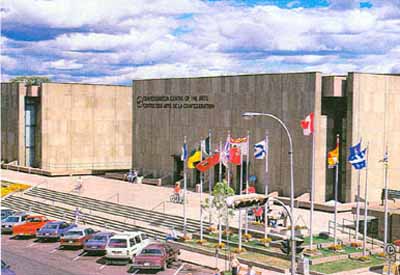Confederation Centre of the Arts National Historic Site of Canada
Charlottetown, Prince Edward Island

General view
© Frank MacKinnon, Honour the Founders! Enjoy the Arts!, Fathers of Confederation Buildings Trust, Charlottetown, 1990, p.67.
Address :
145 Richmond Street, Charlottetown, Prince Edward Island
Recognition Statute:
Historic Sites and Monuments Act (R.S.C., 1985, c. H-4)
Designation Date:
2003-06-30
Dates:
-
1963 to 1964
(Construction)
Event, Person, Organization:
-
Affleck, Desbarats, Dimakopoulos, Lebensold, and Sise
(Architect)
-
George Izenour (designer)
(Architect)
-
David L. Klepper and Russell Johnson de Bolt of Berenak and Newman Inc. (designers)
(Architect)
-
William M. C. Lam (designer)
(Architect)
-
Gérard Tremblay (sculptor)
(Builder)
Other Name(s):
-
Confederation Centre of the Arts
(Designation Name)
Research Report Number:
2002-45, 45A
Plaque(s)
Existing plaque: on stone brick cairn facing Queen St. 145 Richmond Street, Charlottetown, Prince Edward Island
Opened by Her Majesty the Queen in 1964 as Canada's National Memorial to the Fathers of Confederation, the Centre is an outstanding example of an institution dedicated to the arts. The extensive cultural complex includes a theatre, an art gallery, a library and a memorial hall. One of a number of arts centres erected in Canada in the 1960s and 1970s, the building was distinguished by innovations in its acoustics and stage design. With its monolithic outward appearance and extensive terracing, the Confederation Centre of the Arts is a notable example of "Brutalist" architecture in Canada.
Description of Historic Place
Occupying an entire block, the Confederation Centre of the Arts faces Queen’s Square in Charlottetown’s business district. Built in 1963-1964, the Centre is a large, multi-purpose cultural complex executed in the modern Brutalist style. Its four constituent pavilions are distinct yet form a coherent whole and contain a theatre, art gallery and public library clustered in a U-shape around the “Memorial Hall.” It sits adjacent to Province House, the legislature building for Prince Edward Island. The official recognition refers to the building on its legal lot.
Heritage Value
The Confederation Centre of the Arts was designated a national historic site of Canada in 2002 because: as one of a number of cultural complexes built in the 1960s and 1970s in Canada, and as a memorial to the Fathers of Confederation, it is an outstanding example of a national institution dedicated to the performing arts; when it was built in 1964, it was highly innovative in its stage design and acoustics, and featured state-of-the-art lighting and construction techniques; and it is a distinguished example of Brutalist architecture in Canada, which, for its era, is well integrated with the city.
The Confederation Centre of the Arts was built with the intent to inspire Canadians, through heritage and the arts, to celebrate the origins and development of Canada as a nation. The centre was constructed between 1963 and 1965 in the modern Brutalist style to the designs of architect Dimitri Dimakopoulos, theatre designer George Izenour, and sculptor Gérard Tremblay. David L. Klepper and Russell Johnson de Bolt of Berenak and Newman Inc. were the acoustic consultants, while William M. C. Lam designed the lighting.
Source: Historic Sites and Monuments Board of Canada, Minutes, December 2002.
Character-Defining Elements
The key elements that contribute to the heritage character of this site include:
the prominent location adjacent to Province House in the downtown core; the setting facing a square within the business district; the reinforced concrete frame and the exterior faced with solid, continuous walls of smooth-faced sandstone; the low geometric massing of the whole, and the one-storey central Memorial block with a glass roof consisting of a series of skylights, each a pyramidal diamond shape; the three surrounding pavilions arranged in a U-shaped cluster, each with a distinct geometric profile, the visually separate, yet functionally interconnected units of three and four storeys that comprise the whole; the interconnecting levels including a basement, a mezzanine, and balconies; interior pedestrian concourse and exterior plazas, terrasses and steps; the terrace with its sympathetic landscape design, flags and sculptures; the limited number and size, and strategic placement of the windows which provide indirect light; the original interiors and finishes; the functional design of the interior, including the theatre space with its adjustable spatial configuration and adjustable first six rows of seats and the orchestra pit that raise and lower; the theatre interior’s cloud-shaped ‘baldacchino’ sculptures; the two-level pedestrian circulation, and interior concourse.